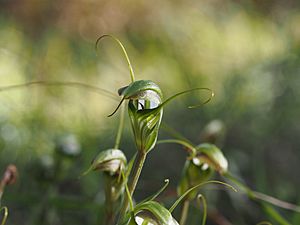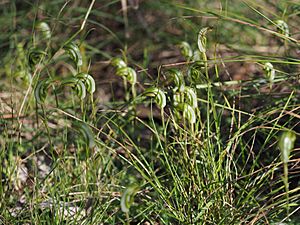Northern striped greenhood facts for kids
Quick facts for kids Northern striped greenhood |
|
|---|---|
 |
|
| Pterostylis divaricata at Gara Gorge | |
| Scientific classification | |
| Genus: |
Pterostylis
|
| Species: |
divaricata
|
| Synonyms | |
|
Diplodium divaricatum D.L.Jones & L.M.Copel. |
|
The Northern Striped Greenhood (scientific name: Pterostylis divaricata) is a special type of orchid. It is found only in northern New South Wales, Australia. This means it is endemic to that area.
These orchids often grow in groups of plants that are genetically identical. This means they are like clones of each other! How the plant looks depends on whether it is flowering or not. When it's not flowering, it has a flat circle of leaves on the ground. This is called a rosette. But when it flowers, it doesn't have this rosette. Instead, it grows up to ten amazing white flowers with green and brown stripes. The Northern Striped Greenhood is similar to another orchid, P. striata, but its flowers are bigger. It also has a longer tip on its top petal, which is called the dorsal sepal.
What Does It Look Like?
The Northern Striped Greenhood is a plant that lives for many years. It is a perennial and a deciduous herb. This means it dies back each year but grows again from an underground tuber.
When the plant is not flowering, it has a rosette of five to nine dark green leaves. These leaves are shaped like broad eggs and lie flat on the ground. Each leaf is about 5 to 14 millimeters (0.2 to 0.6 inches) long. They are also about 4 to 11 millimeters (0.2 to 0.4 inches) wide.
When the plant flowers, it usually has one flower on a thin, smooth stem. This stem can grow from 80 to 200 millimeters (3 to 8 inches) tall. There are also three to five dark green leaves on the side of the flowering stem. These stem leaves are about 20 to 30 millimeters (0.8 to 1.2 inches) long. They are also about 3 to 5 millimeters (0.1 to 0.2 inches) wide.
The Flowers
The flowers are a beautiful translucent white color. They have green and brown stripes. The top sepal and the petals join together to form a hood. This hood is called a "galea" and it covers the column (the central part of the orchid flower).
The top sepal is about 35 to 40 millimeters (1.4 to 1.6 inches) long. It is 10 to 12 millimeters (0.4 to 0.5 inches) wide. It slowly narrows into a thin, thread-like tip. This tip is about 5 to 8 millimeters (0.2 to 0.3 inches) long. The side sepals stand upright and are held close to the hood. They have thread-like tips that are about 20 to 25 millimeters (0.8 to 1.0 inches) long. These tips stick up high above the hood.
The petals are long and narrow, about 24 to 28 millimeters (0.9 to 1.1 inches) long. They are about 5 millimeters (0.2 inches) wide and are curved. The space between the bases of the side sepals bulges forward. It has a V-shaped notch in the middle. The labellum (a special petal in orchids) is white with a brown tip. It curves slightly forward and you can just see it above the notch. These orchids usually flower between March and May.
How It Got Its Name
This greenhood orchid was first officially described in 2016. It was named by two botanists, David Jones and Lachlan Copeland. They first called it Diplodium divaricatum. This description was published in a magazine called the Australian Orchid Review. The plant they studied was collected from Mount Duval.
Later in the same year, the same botanists changed its name to Pterostylis divaricata. They did this to fit with different ways scientists classify plants. The second part of its scientific name, divaricata, comes from a Latin word. It means "spread apart." This refers to how the tips of the side sepals spread out.
Before 2016, this plant was known as Pterostylis sp. aff. alata. This was a temporary name used before it was officially described.
Where It Lives
The Northern Striped Greenhood grows in woodlands and forests. It likes to grow with grasses, ferns, and shrubs. You can find it in the higher areas between the New England Tableland and Mummel Gulf National Park.


